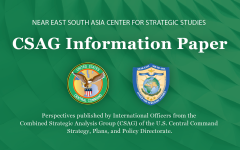China’s New Military Posture in Central Asia
May 5, 2022 2022-05-05 15:25China’s New Military Posture in Central Asia
China’s New Military Posture in Central Asia
By: LTC Andrea ZANINI, ITA A, Action Officer, CSAG CCJ5
26 Apr 2022
Overview:
The US has always faced significant challenges in establishing their presence in Central Asia, which has traditionally been considered as an area of Russian security influence. The Kremlin’s strategy to maintain regional hegemony in its neighbourhood includes establishing close ties with local “pro‐Russia” regimes, a military presence in Central Asian countries, supporting Russian ethnic minorities and marginalizing Western and Chinese influence. Since 2014, China has become a major trading partner for Central Asian countries and a major investor in the energy sector. Furthermore, in 2015, China and Kazakhstan expressed their common willingness to link the BRI with Kazakhstan’s “Nurly Zhol strategy” as a prelude to long‐term economic, logistical, and infrastructural collaboration.
In parallel, Uzbekistan announced its commitment to link its New Development Strategy to the BRI. Although directly involved in the initiative, the Kremlin interpreted the BRI as an attempt to lure Central Asian countries into China’s geo‐economic orbit, at the expense of the Russian‐led Eurasian Economic Union (EAEU), of which Kazakhstan and Kyrgyzstan are members. China’s access to regional energy resources clearly runs counter to Russia’s goal of maintaining a monopoly on control of the energy sector in Central Asia.
Moreover, at the institutional level, China plays a leading role in initiatives such as the Shanghai Cooperation Organization (SCO). Established in 2001 for the purpose of fostering political, economic and security cooperation, the SCO now has eight full member states (China, Kazakhstan, Kyrgyzstan, Russia, Tajikistan, Uzbekistan, India, Pakistan).
In 2017, China inaugurated a military base in Djibouti, marking a radical change in China’s policy, which has been based on not stationing troops or establishing military bases abroad. In the same year, several reports emerged about the presence of Chinese military personnel in Tajikistan. In the past months, more reports have emerged about Chinese military in Equatorial Guinea, forcing many to call it “China’s Military Engagement along the Silk Route”. Therefore, if it is legitimate to think about further increasing of China’s military presence in Central Asia, then some questions arise spontaneously: Can China’s presence to secure its vast BRI network in Central Asia affect the security balance in the region? And can Beijing’s military competitiveness in Central Asia lead to a Russia–China divergence in such a status quo?
Key Points:
- China’s Belt and Road Initiative (BRI) determined a change of its policy in Central Asia from a purely economic to an economic and security policy.
- In recent years, China has increased its military presence in Central Asia by conducting exercises, training military professionals, upping its arms assistance and export, and building up military infrastructure.
- China’s military footprint in Central Asia is expanding mainly in the so‐called “weaker” nations, while other nations with a relatively stronger economy and security structures are resisting Chinese pressure.
- China’s growing military presence in Central Asia impacts not only this region, but also its neighboring countries, especially Russia, India and Pakistan.
The opinions and conclusions expressed herein are those of a number of international officers within the Combined Strategic Analysis Group (CSAG) and do not necessarily reflect the views of United States Central Command, not of the nations represented within the CSAG or any other governmental agency.



